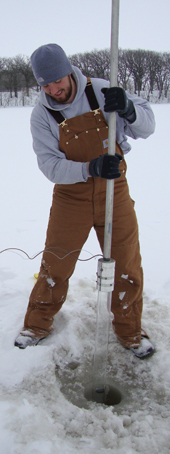Examining history of Iowa’s lakes reveals past, helps set goals for future: ISU study
02-21-12
Contacts:
John Downing, Ecology, Evolution and Organismal Biology, (O) 515-294-8880, (M) 515-231-5376, downing@iastate.edu,
Adam Heathcote, Ecology, Evolution and Organismal Biology, 515-294-3523, aheathco@iastate.edu
Christopher Filstrup, Ecology, Evolution and Organismal Biology, 515-294-6363, filstrup@iastate.edu
Mike McGhee, Iowa Department of Natural Resources, 515-281-6281, mike.mcghee@dnr.iowa.gov
Dan Kuester, News Service, 515-294-0704, kuester@iastate.edu
Examining history of Iowa’s lakes reveals past, helps set goals for future: ISU study
AMES, Iowa -The state's natural lakes were not all as crystal clear as people like to think before early farmers cleared the tall grass prairie and tilled the soil, Iowa State University research shows.
 Adam Heathcote,
graduate assistant in John Downing's lab, looks at a sample
core from an Iowa lake as part of the study. Courtesy photo.
Adam Heathcote,
graduate assistant in John Downing's lab, looks at a sample
core from an Iowa lake as part of the study. Courtesy photo.
The Iowa Department of Natural Resources is working to restore lake water quality, and recent Iowa State University research is making that possible, in part, by helping understand what the lakes looked like in the past.
A recent three-year study by an Iowa State University research team led by John Downing, professor in the Department of Ecology, Evolution and Organismal Biology; Adam Heathcote, graduate assistant; and Christopher Filstrup, post-doctoral researcher, looked at changes in sedimentation rates and sediment composition in 34 Iowa lakes from as long ago as 150 years.
According to Downing, some results from the study were surprising.
"First, I would say that this idea that all of Iowa's lakes were uniformly pristine before we started to clear the land to build cities and for agriculture more than a century ago is not necessarily true," said Downing.
"Second, while our lakes have changed pretty dramatically," he added, "with this study, we can now assess how much they've changed and see what types of practices need to be put in place to correct them."
Nutrients in the water, along with runoff from the soil in a lake's watershed, have an impact on water quality. A century ago, Iowa's lakes often had aquatic plants that provided valuable fish habitat. Over the years, changes in how Iowans have managed the watershed have caused the lakes to change.
The biggest events changing the lake water quality were the initial clearing of the tall grass prairie after the Civil War; urban sewage runoff into lakes starting around 1900; urban expansion and rural agriculture that have created more runoff leading to more sediment; increased use of fertilizer starting in the 1940s; and the Clean Water Act of 1972, according to the researchers.
Increased runoff often leads to the water getting less clear, which, in turn, shades out the aquatic plants. The result is that algae populates the lakes and can cause large algal blooms, researchers said.
While most of Iowa's lakes have seen an increase in erosion and phosphorous during the past 150 years, the researchers think most of the lakes are repairable.
"Restoring these lakes can be done," said Heathcote. "It depends on the stakeholders around the individual lakes and how committed they are to improving local water quality."
Downing says small changes can make big differences in water quality.
"It has been shown over and over again, that just a small part of the watershed supplies most of the nutrients. Small improvements to the plumbing of watersheds makes a big difference," said Downing, who has published research on Iowa's lakes and ecosystems and studied the issue with the Iowa Department of Natural Resources for several years.
The research was funded by the DNR to give the state baseline information to set restoration targets for lakes around the state.
"This research gives us additional critical information to focus on what needs to be done and what can be done in restoring these lakes," said Mike McGhee, from Iowa DNR's Lake Restoration Program.
The study was one of the first steps in the Iowa DNR's efforts to restore Iowa's lakes to previous conditions.
One of the more interesting results by the researchers showed that Iowa's different lakes had very different amounts of nutrients and sediment even before the introduction of cities or large farms.
"Although we can't travel in time to look at water quality in the past, limnology [the study of inland waters] gives us a lens through which we can observe the past. When we start looking at restoring these lakes, we first need to understand what they looked like before," said Downing. "What we have found is that these lakes did not all have the same quality of water to begin with. When we start talking about restoration, we need to keep these things in mind. Getting all these lakes to a perfectly pristine state would be like taking your Toyota to get fixed and expecting it to come out a Mercedes."
The study involved taking core samples from 34 of the state's lakes and examining different stages of each lake's history.
For most lakes, the core samples allowed researchers to examine more than 150 years of history. Because of the density of the sediment, other lakes could only be measured for about 100 years, or sometimes less.
The core samples are 2 ¾ inches in diameter and were extracted by physically pushing a hollow tube into each lake bed. The core samples were then pulled out of the lake with a piston-aided vacuum device in the tube that kept the sample whole and didn't allow the sediment to spill out the end of the tube.
Cores were studied for amounts of carbon in the sediment, and the amount of inorganic material - mostly sediment from runoff and nutrients and organic matter-producing organisms that lived in the lakes - either rooted plants or algae. The fossilized remains were used to reconstruct how nutrients have changed over time.
Samples were up to 6 1/2-feet long and were photographed immediately after extraction to record the color of the core prior to exposure to air, which can cause the colors to change after being buried for as long as 200 years.
Dates of each section of the cores were determined by using a method similar to carbon dating that uses a radioisotope of lead that falls out naturally from the atmosphere. Researchers could also then date between 15 to 20 sections of the core and determine how much sediment was deposited during each time period.
Examining the cores revealed that natural lakes in Iowa have filled up at an average rate of about 1/10 of an inch each year since 1850, and have accelerated to as much as 1/3 inch each year in the last decade.
The researchers estimate that Iowa's natural lakes were filling in with one foot of sediment every 430 years prior to settlement compared to an average of one foot for every 35 years over the last decade.
-30-



